Intro + Interviews by Adam Abada
Header Collage by Requiem For A Screen
The World Trade Center — with its centerpiece, the Twin Towers — opened just a few months before the Knicks won their second championship in 1973, and symbolized a new, modernized era of New York City. As literal twins, the Towers are excellent symbols for the push and pull of capital versus culture which, by the 70s, was really coming to a head in American society. They were the biggest buildings in the world and just one wasn’t even enough.
Many of us are still trying to understand what happened on September 11th. Most, like me, can’t find the words to accurately pay tribute to the lives lost and the lives forever changed by the collapse of the Twin Towers. So we use images. Every year, people post their favorite photos of the Towers in an effort to “never forget.” What are we not forgetting? Not just the lives lost too soon, but that our time isn’t even ours, that it is an ephemeral gift whose best use is ours and ours alone to decide.
In an effort to help myself come to terms with a world that can change so radically in so short a time, I decided that instead of re-posting my favorite photos of the Towers, I would talk with some of the people who shot them.
GIOVANNI REDA
When did you start shooting skate photos?
In the early to mid 90s.
How did you use architecture and the built environment in your skate photos?
I’ve never really thought about it because the city was always just part of the landscape. Growing up in Brooklyn, when I started taking photos, the built environment was always a fixture. I wasn’t thinking about it then as much as I do now, which is unfortunate. It probably would have made everything I shot so much better. But at the time, it was just a part of it: there were these buildings and they’re gonna be there.
Even as a kid, though, I did notice how photos of the city always stood out from photos in California. There’s blocks in the financial district — before they did the zoning laws about how high you can build — that never see sunlight at all. You’ve got buildings that are 60 stories up, just a few feet off the curb.
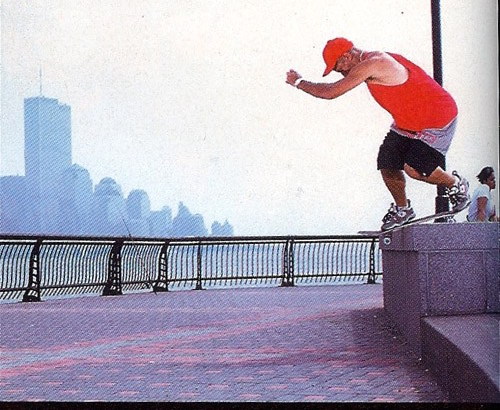
You have a lot of photos featuring the Twin Towers. Let’s start with the Felix Arguelles shot. Did you consider the Towers in that photo?
In that photo I definitely did. It was pretty overcast that day, so it wasn’t the best day for photos. The Towers are a little bit hazy. I think Felix was staying at my house, and I knew he wanted to go to Hoboken because it was a good spot to go to during the week — you never got kicked out. I’m pretty sure that was Felix’s call. I know him enough to know it might have even been his idea to get the Towers in there.
How about the Danny Supa shot?
I was definitely thinking about them — I thought it’d look sick with the Towers in the background, especially with that trick. With a lot of the photos, you’d want to shoot the way the skating looks best. And then if you can get the Towers, or the Empire State Building, or an iconic building — or even just any old building — and arrange them in a way that makes the photo much more dynamic, you were stoked! I have another photo of Spencer Fujimoto nollie back tailing down below the Towers that looked pretty dope.
Can you tell me about that Todd Jordan photo? What was it like shooting that so shortly after they collapsed?
In those days, it was all about the spot and trying to get a trick. Either me or Todd thought of doing that trick — switch back tail the step-up ledge in Hoboken — and we decided to go. Those people just happened to be there with the memorial, looking at it. The circumstance was a gift. When you get it, you gotta take it.
Did you think of the Felix photo when you were taking it?
You know, I did, because in those days you would think of what tricks went down at the spot. “Okay: Anthony Correa switch crooked it, Dill front crooked it, Richard Mulder noseblunted it, Felix back lipped it.” That was it. I was younger and I wasn’t thinking the way I think now about shooting a photo.
What do you think gives the Twin Towers such distinction?
I mean, it was such an iconic skyline. It’s an iconic skyline even today, but I think the Towers really made it stand out. You knew that city anywhere. Everybody skated downtown. You were always in the shadow of the Towers, in one way or another. The Towers personified everything New York. If you were able to get a skate photo with the Towers in there that made the photo even better.
What do you think about the photo today?
I’m glad I was able to shoot what I shot when I did. You’ll always shoot at spots that have the chance to no longer exist. Sometimes everything’s gone. They put a new building in, or ripped a building out, whatever it is. I didn’t know that would be the case with this, but it’s always a possibility.
Now I gotta go shoot a photo with the Freedom Tower in the background so I can have all three: with the Towers, without the Towers, and with the new tower. I’ll see if I can get Todd to dust off his skate shoes and switch back tail it again.
MIKE O’MEALLY
When did you start shooting skate photos?
I think in 1992. So, what’s that? 27 years ago?
How do you use the built environment as a part of your compositions?
That’s probably 50-75% of the composition of my photos. If there’s buildings in the environment and it’s interesting, then it will play a massive role in my photos. I try to accentuate that as much as possible while still highlighting the skating. I grew up in Sydney and moved to New York, and it was all about that for me.
With New York, you couldn’t really ask for a better backdrop as a young photographer. I try to shoot photos that will appeal to the everyday person who doesn’t really know what tricks are. I want any civilian to look at a picture and appreciate it. The backdrops and the environment are a big part of that for me. I like a photo that’s a good photo — but just happens to have skateboarding in there.
Do you remember taking that photo of Bobby?
I do, actually. It was at the end of a really long day of skating all around Manhattan and Brooklyn. I think the crew was Bobby, Kenny Reed, Jerry Hsu, this kid Travis Graves and a couple other people. I’m sure I’m forgetting somebody. I want to say Danny Supa was there, possibly. That quarterpipe had just been built. I think Nevitt, who used to run KCDC, built it with some buddies. It was probably not that old when that photo was shot.
Obviously, back then there were no iPhones or Instagram or anything. I’d just heard about it and I think maybe Bobby took us there — I don’t really remember all the details. I think Jerry and a bunch of people were skating it, but Bobby was floating those ollies really nicely. We were in Greenpoint, so if you face south, the Twin Towers are right there. It didn’t really take a lot to put that photo together. You’d have to be a real knucklehead to mess that up.
Why do you think the Twin Towers have the distinction of being photographed so much?
I think a lot of it is geographical. Anywhere in the city, you pretty much get a clear look at them. Even from Jersey. There’s not much else around them in terms of other skyscrapers. Once you get to midtown, there’s a lot more going on. Manhattan is basically a long, straight island and they’re just right there on the bottom, a beacon marking the end of it.
How do you feel about the photo now?
There is a lot to be said about it – you could go pretty deep into its meaning. Bobby always thought it was just an ollie on a quarterpipe, you know? For him, that’s sort of a low on the ladder trick. Everyone else grew to appreciate it because it’s probably one of the last skate shots of the Twin Towers. It sort of represents a simpler time, when things weren’t so complicated. It’s golden hour and sort of represents a kind of golden era in skating. For me it really represents the end of a great day of skating.
That’s part of the reason that photo shines. It’s taken on a lot more meaning because of the tragedy of them being knocked down, but originally, I just took it as a great photo of a great day.
I shot that in June 2001, just a couple of months before they were taken down. The photo didn’t come out till December, actually. The turnaround in magazines then was three months, so by the time September came, we didn’t know what to do with it. They ended up running it as an editorial — I think the editorial column was called “The Finish Line,” and there were some appropriate words alongside it. We ran an article that I shot about skating around Manhattan on September 11th, so I think it was presented in a historical context. And then, of course, the photo speaks for itself.
BRYCE KANIGHTS
When did you first start shooting skate photos?
I started shooting as a kid in the late 70s, and then got into punk rock and all that as skateboarding kind of died. I got back into skateboarding in 1980 or 1981 and I picked up my camera again, so I’d say ’81 or ’82 is when I started really shooting as a hobby. Then I got hired at Thrasher, and started really going into it.
How do you use architecture and the built environment in your photography?
As skaters, we’re always looking at architecture and how it applies to what we do. You think to yourself, “Whoa, that’s skateable. Or that could be skateable if you add a piece of wood.” So, I’m always looking at angles and how certain features of a design of a building or plaza can apply to skating. In a photographic sense, I’m always looking at light and where it’s coming from — east to west — north light, which is shadow and shade, at least in the northern hemisphere. I’m always looking at light and form, and that’s how I apply my photography to skateboarding.
Tall skyscrapers are awesome, especially with a fisheye because they loom large over your subject matter.
Can you tell me about taking the photo of Bruno Musso?
In this shot, the Twin Towers are looming over him. That was in June of 1989, and it was my first time in New York City. Those were the tallest buildings back then. I was just so enamored with going down there and getting a photo. I met up with Bruno and the Shut crew — Harold Hunter, Rodney, Coco Santiago. It was a bunch of us, I can’t remember them all. We just pushed through the streets and made our way to the Twin Towers and got that photo. The shadows that those buildings cast were so unique. The way those Towers were oriented, that plaza never saw the sun, pretty much. We went there three times during that trip, and it was always shadowed.
Did you have that photo in mind?
Not really. It wasn’t like we were going to go down and shoot this photo of this trick. We just were pushing through the streets and ended up there. I did have in the back of my mind that I’d love to get a photo at the Twin Towers. Being from the West Cost, we had tall buildings in San Francisco, but not the World Trade Center. We were just pushing around doing flatground tricks — basic 80s street skating. I said it’d be rad if Bruno did a G-Turn. He did it right in front of me and we shot a few. Jeremy Henderson did a few of them as well. I think I shot two of each and that was it. That was the moment.
Why do you think the Twin Towers got such a distinction and focus in skate photos?
For one: they were two identical buildings that converged at the corners. That was pretty cool. There’s a few other structures, like the St. Louis Arch, that are really photographically amazing for skateboarding — there’s some rails there that are insane. I don’t know if they’re capped now, but they were not in 1994 when we went there. There are certain structures that just lend themselves to great skate photography.
But back to the Twin Towers: since there were two of them, with a fisheye they converge at the top of the frame in a photo. They were the tallest buildings at the time. It’s pretty cool.
How do you feel about the photo today?
Would that photo be so significant now if those Towers never fell? It’s not my technically best photo. I think it was underlit; I didn’t have a lot of flash gear with me. I just shot with a fisheye and an on-camera flash. I got the moment. Half of photography is being there and we were there. Technically, it’s not the best photo, but it did capture how street skating was at the time. It was great for what it was. I’m glad I was able to capture that moment. It is at Ground Zero. It’s very sad that happened. It shows a time of how free skateboarding was in the streets of New York. We could do what we wanted. We did not get kicked out of that area at all. We never saw a security guard.
PATRICK O’DELL
When did you start shooting skate photos?
In the early 90s I would say — I went to high school in Columbus, Ohio, and I guess I started shooting skate photos there. I made ‘zines, and tried to submit stuff to Thrasher.
How do you use the built environment in your photos?
I think a lot of skate photographers use architecture. Skating itself is sort of architecture. Sometimes you get to a spot, and it’s cool but the architecture looks boring. A photo behind a Walmart somewhere is not going to be that cool. I’ve been there, where you’re shooting behind a grocery store and it’s just …boring. New York City gives you the opportunity to have really unique photos pretty much anywhere.
Do you remember shooting this photo?
The way the picture looks was the whole mission. Ian had the idea for the photo. He had the spot and what he wanted to shoot. It’s crazy that it’s in Brooklyn. The Towers were just so giant. You could shoot a photo in Brooklyn and it looked like they were right there.
It was funny, because there were a lot of skaters who were better than him at skating, I guess, but he always had good ideas for pictures. He’s an artist and is a photographer now, and he always had good ideas for whatever spot we were at. Now, it’s what I think people look for. Skating was in a phase back then where people just wanted the best trick: most stairs, biggest rail, most technical trick. Nowadays I feel like you could easily run photos like that. It was just a backside tailslide on a ledge but he had the idea lined up. He pretty much directed the whole thing. I had a long lens — maybe not that long — probably 200 mm all the way zoomed in, tripod and everything. It was pretty easy to shoot. I remember lugging my bag around and wondering if the trick was good enough, and then being pleasantly surprised when Thrasher ran it. There’s those photos that you send in on the side with your bangers and you don’t think they’re gonna run. I thought maybe it would be better if it was a backside noseblunt or something.
What do you think it is about the Twin Towers that gives them that level of distinction?
They were giant. They always scared me a little bit. You would use them as a — what’s it called? — to get your bearings….a lodestar. I looked it up: “A star used to guide the course of a ship, especially the North Star.”
They were so big that they were always present. I remember if you were driving to Manhattan from South Jersey or Philadelphia, you would see the Twin Towers and you would be like 45 minutes to an hour away still. You’d see them from really far away. From anywhere. Maybe in Paris, the Eiffel Tower is like that — it would catch your eye no matter where you were. The other buildings down there didn’t touch them. I don’t think the new building down there has that effect, either.
How do you feel about the photo today?
I think of other photos as being more iconic: the Peter Bici backside ollie, for instance. That’s the most iconic one to me. And I was there when Bobby Puleo did that backside ollie. I remember doing a frontside rock on that quarter pipe, and Mike O’Meally’s flash went off. Maybe he has a photo of me doing a frontside rock.
I guess I’m stoked on the photo! I kind of forgot about it until it got posted on a September 11th, I think. My memory can be a bit foggy from back then.
DIMITRY ELYASHKEVICH
When did you start shooting skate photos?
I started in junior high, probably in 89 or something, just hanging out with my homies and skating around. I had a little Pentax – no, I had a Yashica K1000, I think. They had a big contest at the Banks and I sent a bunch of photos into all the magazines. Thrasher printed one of my photos of Tim Brauch. They gave someone else credit for it, so I wrote a big letter to Bryce and they put an apology in the next one, so I was gassed. It was good enough to be in the magazine so — sick!
How do you use architecture and the built environment in your photos?
New York is a really photogenic city, you know. I was lucky enough to live and grow up here. For me, the first thing is the skater and the trick. And then, you’re always composing with everything that’s coming through the lens. I feel like it was a bit easier out here. Especially at night. For that photo, we were very lucky to have that bank thing — they were doing construction there and it was only there for two weeks or something. Back then, you had to really pick and choose your photos because it was all film. Now you just pop away.
So you specifically remember that photo. Do you remember shooting the Towers?
Oh, for sure. In the footage, you can see I’m not looking through the lens because it’s real quick and you have to get out of the way. So I looked through it before, framed it up, held it out there, snapped the photo and got out of the way. I always loved the Twin Towers. Whenever I’d be coming to the City from Brooklyn in the car with my parents, I’d always shoot a photo of the Twin Towers going over the bridge. New York’s not the same without them. It still looks weird to me.
What about the Towers drew you into them?
There’s nothing else like them in the city — two giant towers sticking out of all these other buildings. They’re there, they’re solid, peaceful, and powerful all at the same time. Just rising above everything. I’ve been there a bunch of times. I went up on the observation deck and you can see the whole island of Manhattan looking north. You used to be able to go outside on the roof of one of them.
Why do you think they have such a distinction of being photographed so much?
They’re the biggest things around, especially downtown. Nothing came close. They were twice as big as any buildings that were near them.
How do you feel about the photo today? Knowing the bank wasn’t going to be there forever but not the Towers…
If I could, I always tried to get them in a shot. I shot some stuff in Jersey and I’d try to get them in there. I thought they were so beautiful. I went to school right down there. I was a student at Stuyvesant High when the first bomb went off in 1993. That was a crazy day. I lost some friends on September 11th. I definitely remember that day.
I didn’t think it was going to be so significant at the time; I’m glad people like it. It’s just a photo, but it keeps coming up every year. I feel very blessed to have been there. It’s all timing. Like I said, the spot wasn’t even there for too long.
NATHANIEL S. BUTLER
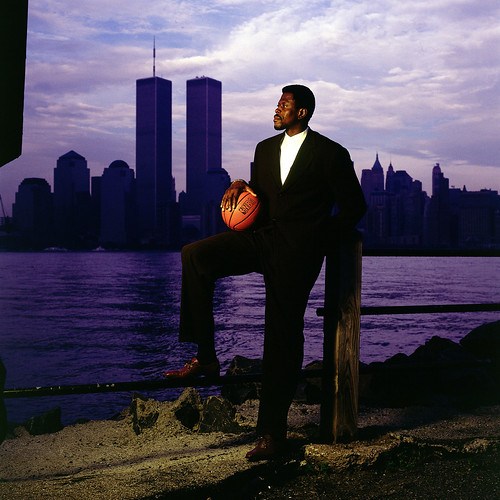
NEW YORK – 1996: Portrait of Patrick Ewing #33 of the New York Knicks across the river in front of the World Trade Center during the 1996 NBA season in New York City, New York. NOTE TO USER: User expressly acknowledges and agrees that, by downloading and/or using this Photograph, User is consenting to the terms and conditions of the Getty Images License Agreement Mandatory Copyright Notice: Copyright 1996 NBAE (Photo by Nathaniel S. Butler/NBAE/Getty Images)
How long have you been shooting basketball photos?
I’ve been doing it quite a while now, for about 30 years or so. I loved sports and photography, and kind of merged the two together. It used to be a lot of in game action for prints, ads and editorials, but a lot of it has changed — a lot of it is social media driven now.
Can you tell me about the photo of Patrick Ewing and the Towers?
The NBA was celebrating its 50th anniversary and they named the 50 greatest players. Patrick was one of those, which was sorta cool. That project was in 1996. The NBA put a book out celebrating those players.
Patrick and I have been friends for years. I’m based in New York, I went to St. Johns — he went to Georgetown. I was excited when he went to the Knicks, for obvious reasons. For that photo, they wanted something iconic in New York. We were thinking maybe Times Square but, at the time, The World Trade Center was the iconic background for anything having to do with New York.
I was in Seattle shooting the Finals; it was Chicago versus Seattle. My wife was pregnant, so I was commuting back and forth from Seattle. We picked a time to shoot this photo when I was home, and it was supposed to be a nice New York sunset kind of shot. Patrick, who was historically late for everything, showed up early for this shoot — it wasn’t even dusk yet. It was the first time since I’d known him he was early for something! He was telling me how he didn’t have much time, and as he was saying that my beeper went off — this was 1996 remember — and I found out my wife went into labor. So it was good he was early because I had to go! So, literally for this shoot that took months of planning and scheduling and scouting that location in Liberty State Park, I shot seven frames of film. It was a couple looks — boom, boom, boom — the shoot was about four minutes long, and for different reasons we were both outta there. And my son was born four hours later. I went straight from that shoot to the hospital.
How do you feel about the photo today?
Well, it obviously has a lot of significance now. I have mixed feelings, probably like a lot of people.
I remember the Towers being built and taking photos of my family with them in the background. It’s a big part of New York. For all of us native New Yorkers, it’s a very, very powerful image. And it changed not just New York, but the world. There’s the whole gamut of emotions when I look at that picture.
I do like, not necessarily the simplicity of the shot, but that he has a stoic look. He’s not spinning the ball or bouncing it or doing anything basketball related. It has a different feel to it that today, gives me a little bit of a remembrance vibe. It’s not super heavy in it of itself but almost twenty years later, it’s very affecting.
Some of these scans are definitely stolen from Chromeball. Thank you to all the photographers for being down to chat with us about these images, and to Adam for rounding up everyone.


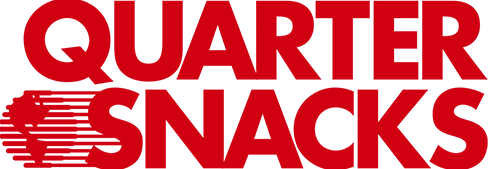
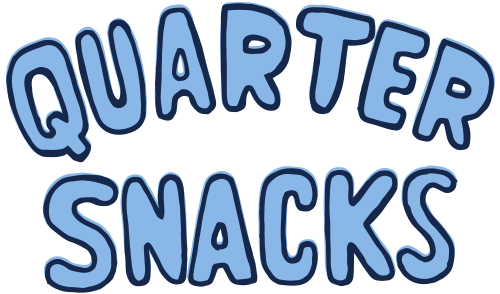
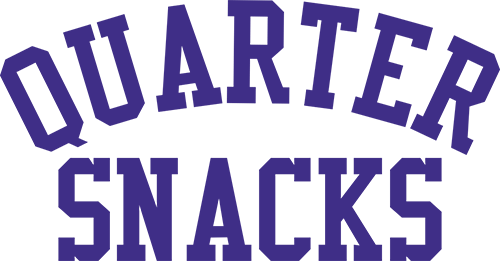

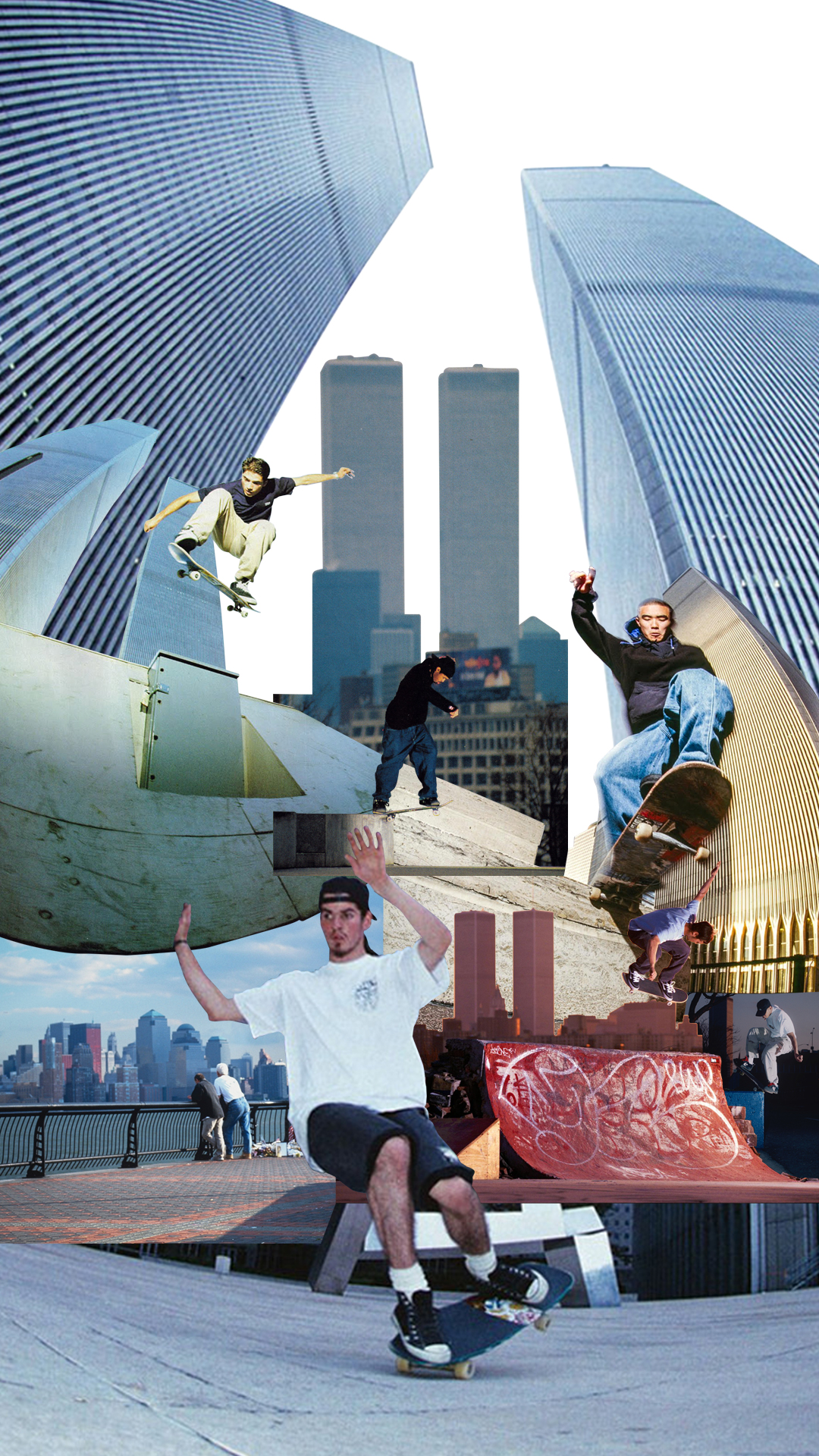
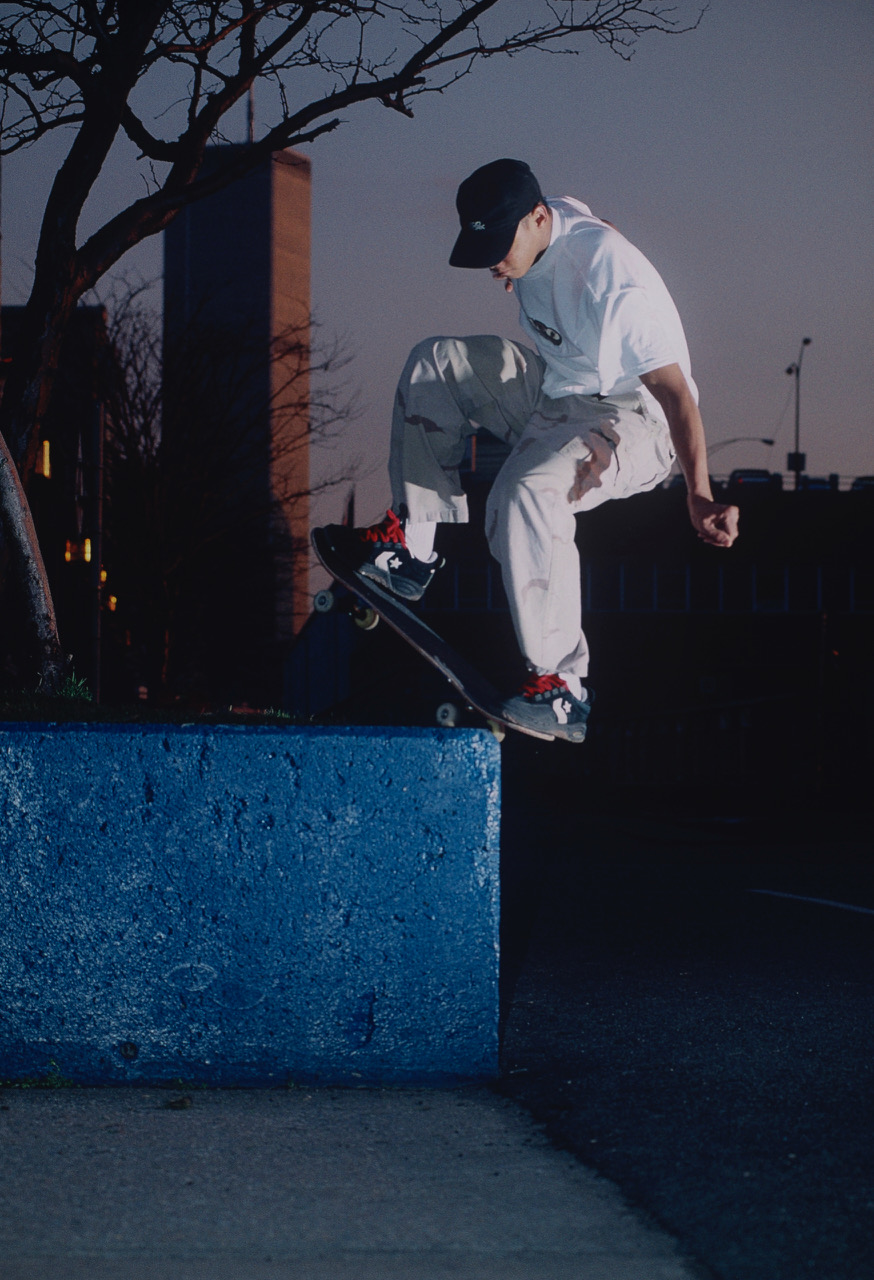
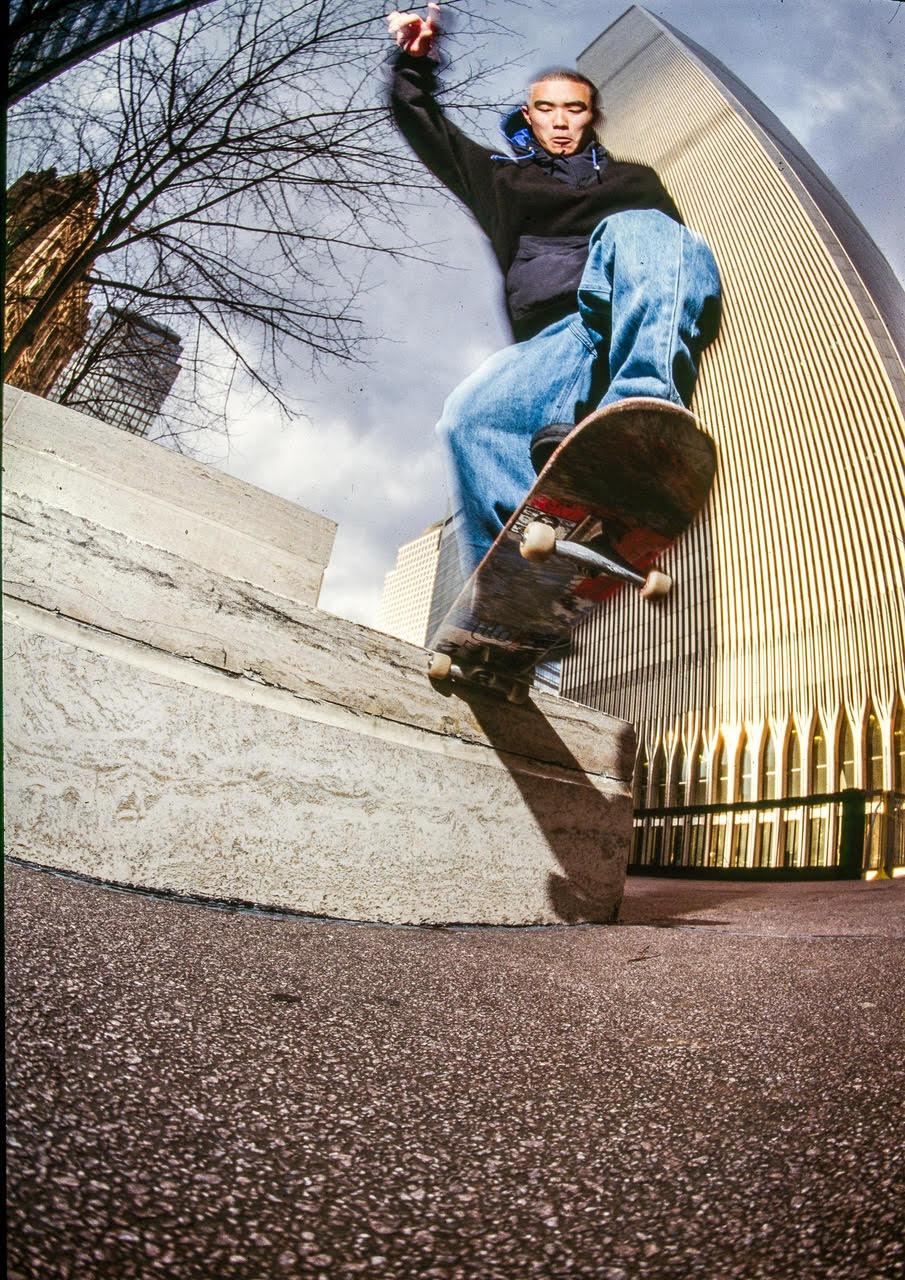
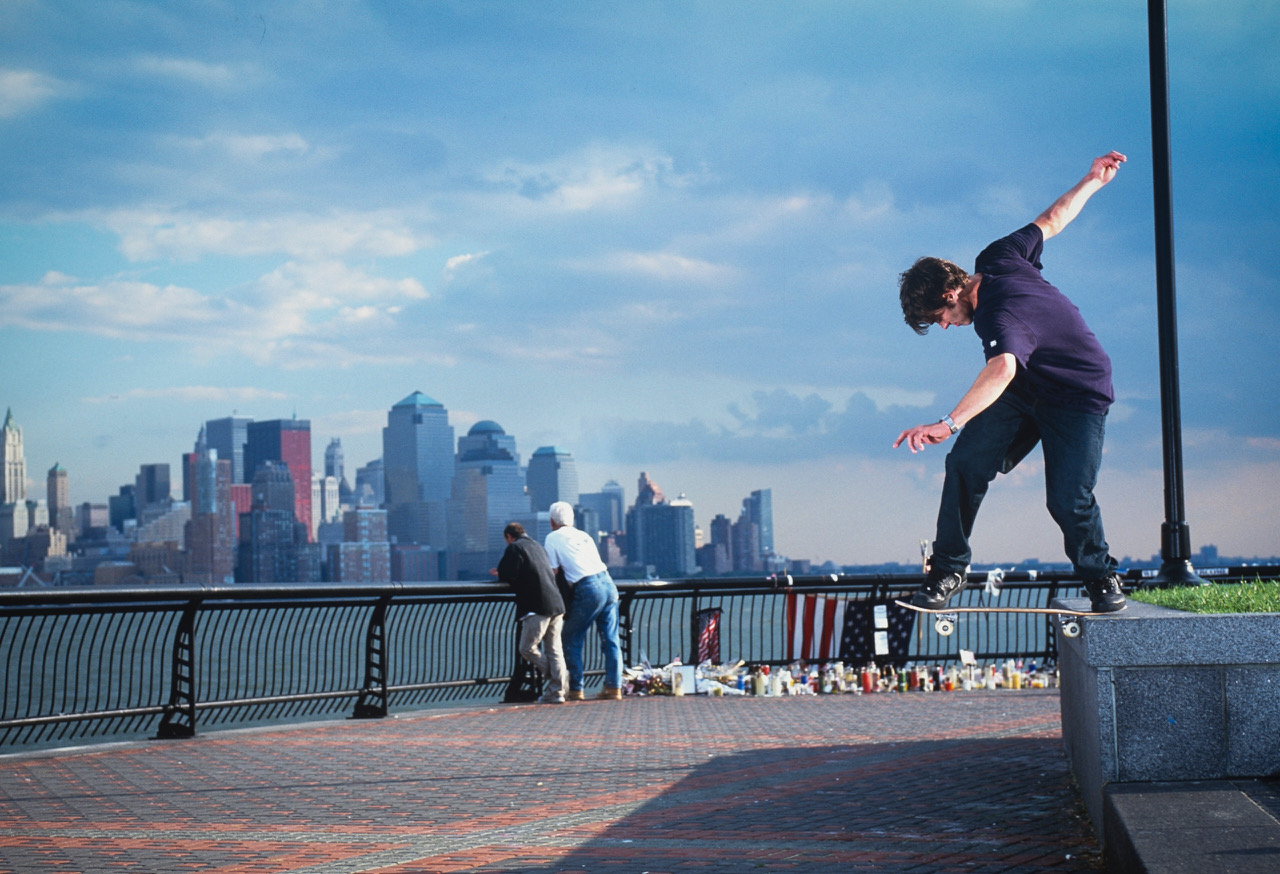
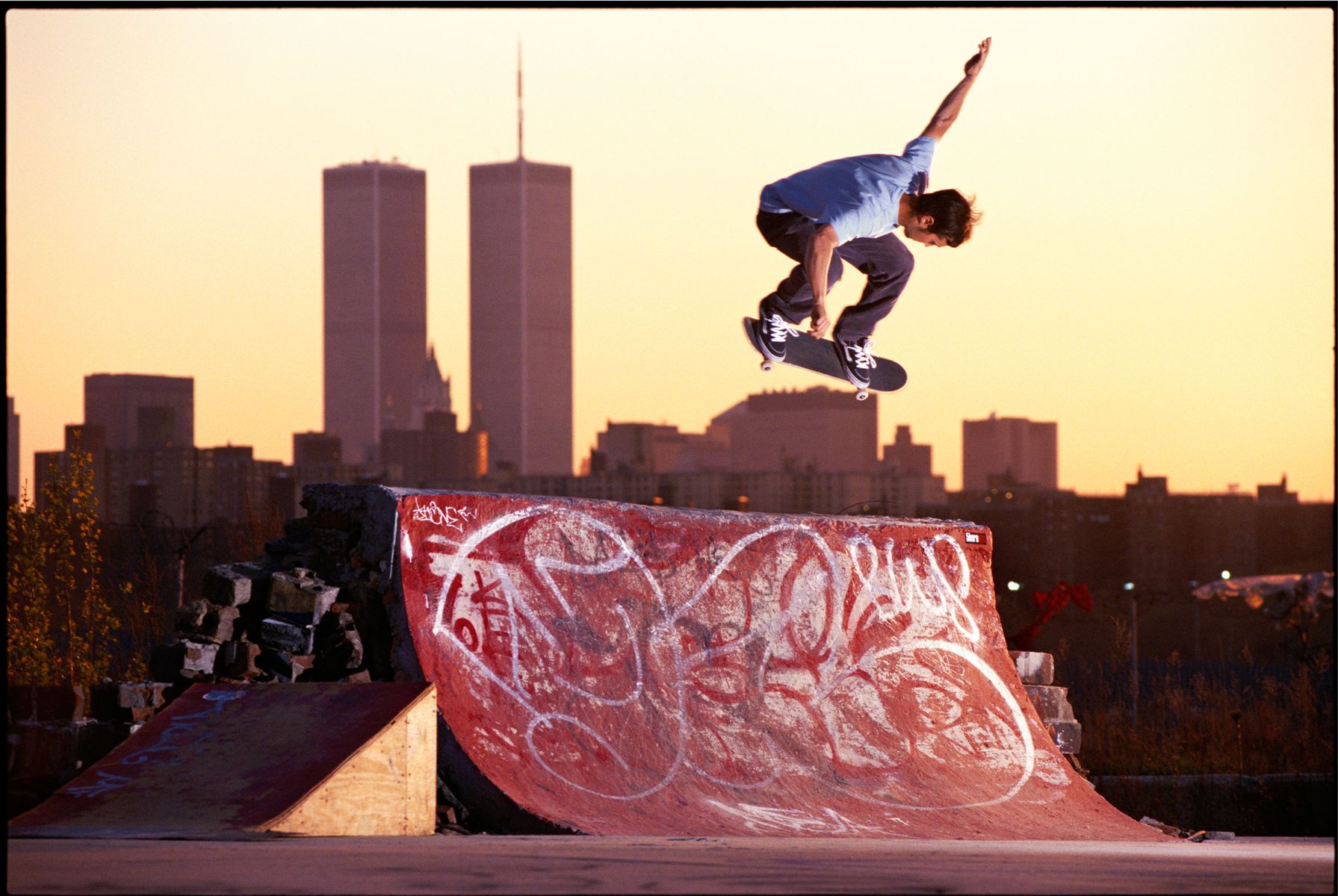
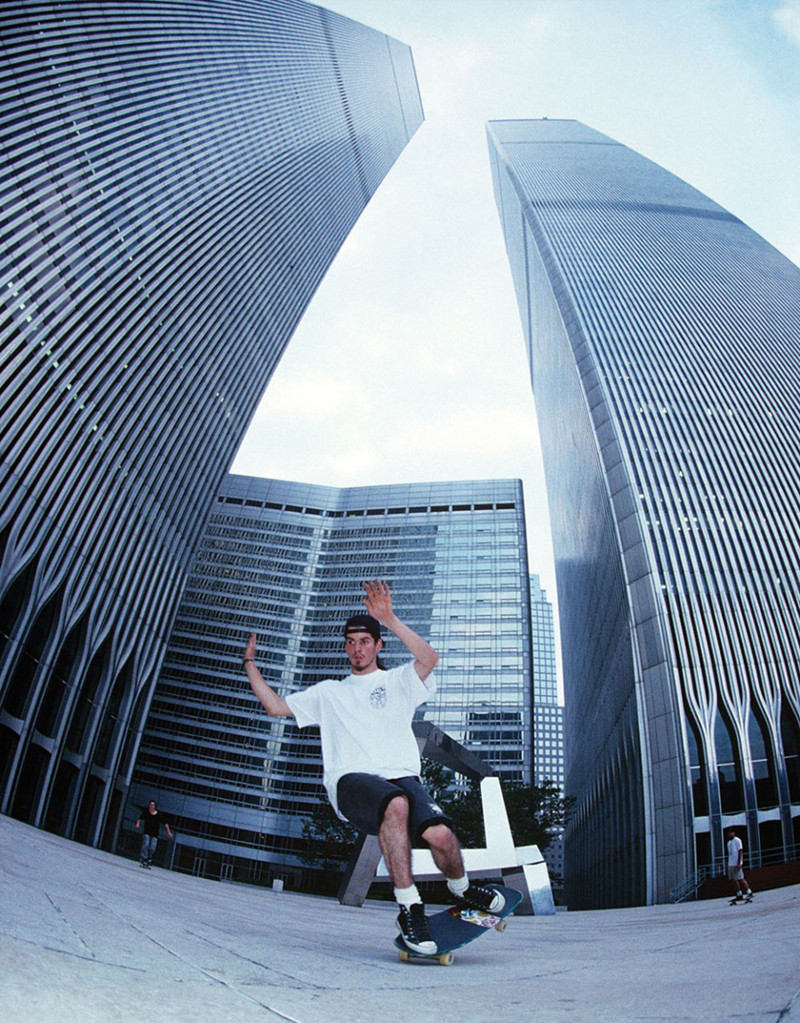
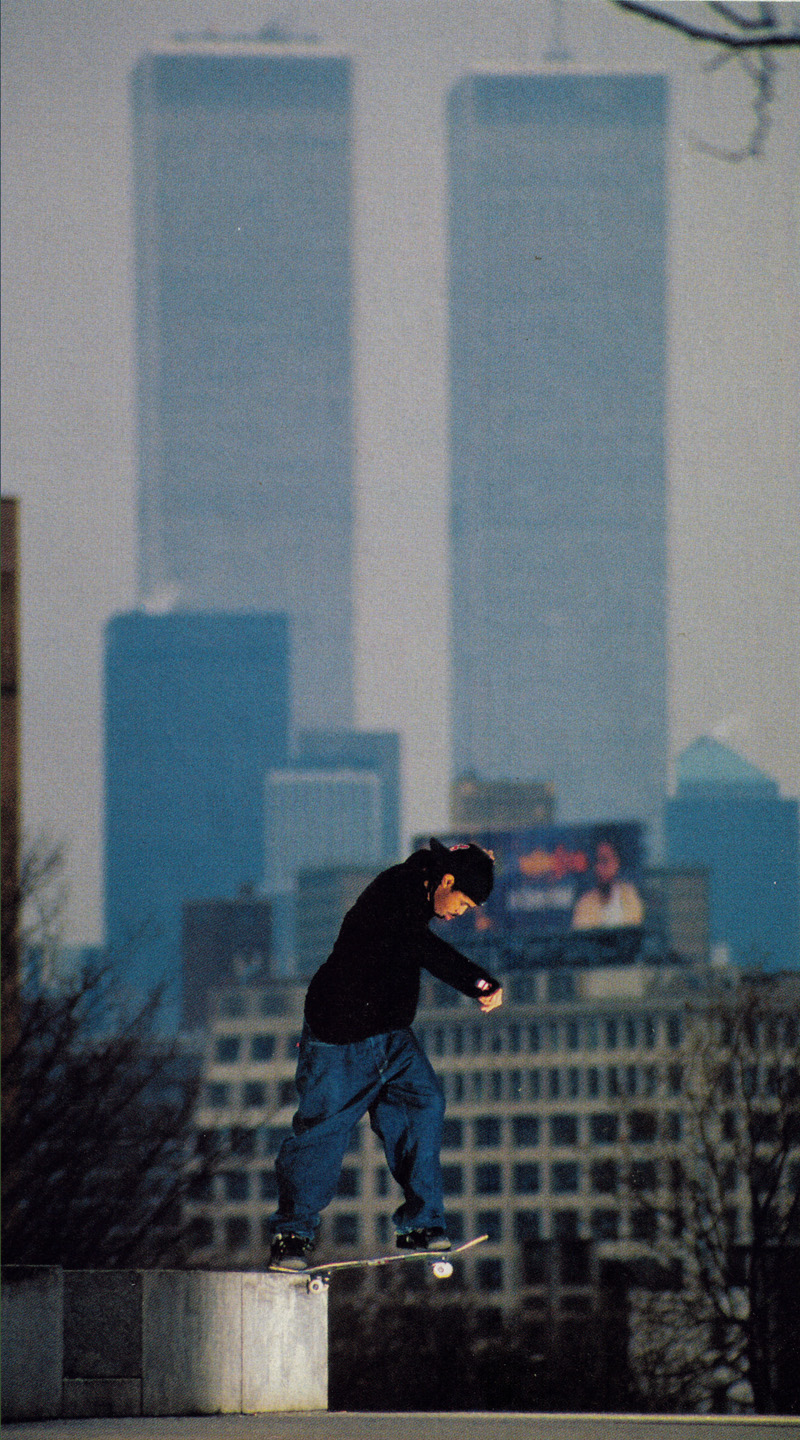
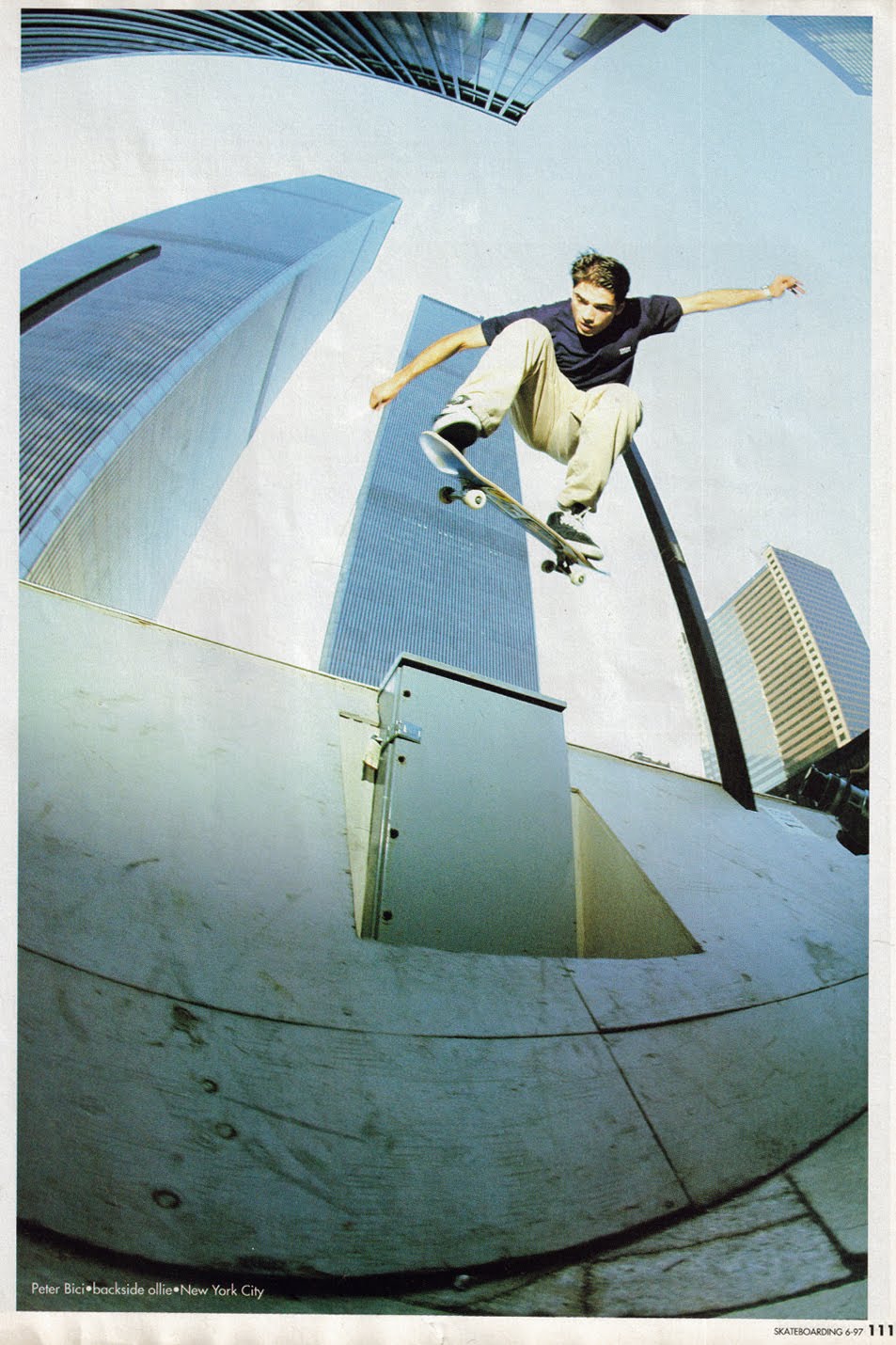
A very powerful article. Thank you.
adam, my dude, this is so good.
Sick
Great interviews and sick insights from the OGs s/o Bici thanks for what u do
“the Twin Towers — opened just a few months before the Knicks won their second championship in 1973…”
And to further put that into perspective for the Quartersnacks crowd: Rhianna was still 14 years away from existing, Nose slides had not been invented and the closest thing to ‘wavy’ music was like, Frank Zappa.
Bravo.
Their 2nd championship was 15* years before the birth of our lord, actually…
This was SOOOO good!!! Thank you for the read!!!
Article was fucking amazzzzzzzzing! All the interviews were rad.
Not trying to be “that guy”, but there should be some mention to Harold’s pic sketching the car with the towers in the back. :)
RIP WTC and all the victims.
Thank you
rlly good story dude
“It was funny, because there were a lot of skaters who were better than him at skating, I guess, but he always had good ideas for pictures.” – Patrick O’Dell
asshole thing to say for real …
Wondering how that photo of Dill didn’t make it on this list…
you mean the one where he managed to turn 9/11 into being about himself?